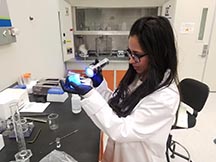Updating GALPROP Cross-Section Database to Further Explore
Cosmic Ray Origins
Priyarshini Ghosh
CRESSTII
The Catholic University of America
Goddard Space Flight Center
Wed, Sept. 7 , 2022 - 4:00 PM
In-Person: 108 Hannan Hall AND
Zoom: https://cua.zoom.us/j/86174256595?pwd=R1RhN1dDdElUQUdKb2VYVHJNNGtMZz09
Cosmic rays are highly energetic particles from outer space, consisting of mainly protons (90%), helium nuclei (9%), and heavier nuclei (1%). To understand the origins of cosmic rays, their energy spectra and composition are studied by obtaining data from ground-based measurements, space-based instruments, and interstellar probes Voyager 1 and 2. While the Solar System (SS) abundances and Galactic Cosmic Ray (GCR) abundances of elements bear the same even-odd effect (indicating a stellar origin for the GCRs), there is an overabundance of several elements from GCRs and compared to SS abundances, indicating the importance of studying propagation in the Interstellar Medium. CRs can be directly detected, or indirectly, as gamma rays or X rays, upon interaction with the interstellar gas. GALPROP had begun development in 1996 to model the complex GCR propagation and support experimental data to better understand the make-up of the galaxy. Since its inception, there has been a continual flow of new and more accurate data from space, balloon and ground-based experiments, as well as accelerator experiments on Earth to produce spallation cross-section data of heavier elements. In fact, the previous lack of cross-section data in heavier elements was proving to be a bottleneck in complementing experimental elemental abundance data. Therefore, to complement the influx of more accurate experimental data, corresponding improvements in the accuracy of cross-section calculations is necessary, especially for heavy nuclei (>Fe) and at high energies. This endeavour requires a thorough examination and compilation of experiments of cross-sections for different reaction channels. It is important to differentiate between individual, cumulative, charge-and-mass-changing, metastable states, decayed cross-sections. Experiments can also be of different types such as using reverse or direct kinematics, and can use different methods of data measurement such as mass spectroscopy or -ray spectroscopy, etc. Currently, we are reviewing recent experiments and creating a system to quantitatively determine what data can be relevant for our purposes. Once GALPROP reaches a significant milestone in updating its database of cross-sections, the next step would be to compare the predicted abundances and spectra with those of future planned missions such as TIGERISS, especially with heavier elements (Fe<Z<Pb) and at higher energies (up to 10 TeV).
If you have any questions about the Colloquium Series, would like to request disability accommodations or would like to make a donation please contact the Physics Department, cua-physics@cua.edu or call (202) 319-5315.
